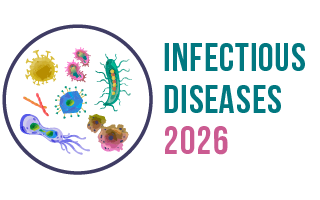4th International Conference on
Infectious Diseases
September 09-10, 2026 | Barcelona, Spain

Infectious Diseases 2026

Univeristy of Athens, Greece
Abstract:
Necrotizing Soft Tissue Infections (NSTIs), including cellulitis, fasciitis, myositis/myonecrosis, and perineal necrosis (Fournier’s gangrene), continue to pose a significant challenge in everyday clinical practice due to associated mortality from bacteremia and multiple organ failure, which ranges from 8% to 17% in recent studies (compared to over 50% in previous decades). In cases involving legs with atherosclerotic or diabetic angiopathy, the need for amputation can be as high as 26%, even in recent studies.
The microbiology of NSTIs is diverse and varies according to the affected area and type of infection—such as the body, perineum, legs, or postoperative wounds—and may include Gram-negative aerobes or anaerobes, Staphylococci, Streptococci, and Clostridium, whether gas-producing or not.
The clinical presentation and symptoms are also varied, often making diagnosis and evaluation challenging, particularly when deciding on the need for surgical intervention. Diagnostic methods have evolved beyond plain X-rays, which primarily reveal air from gas-producing microorganisms, to include CT scans and, in some cases, MRI. The Lrinec Scoring System encompasses a range of laboratory tests for evaluating necrotizing fasciitis.
Current therapeutic protocols include: a) Broad-spectrum antibiotics (or combinations) administered intravenously immediately upon suspicion of diagnosis; b) Early aggressive intervention to remove all necrotic tissue and perform fasciotomies in cases of suspected compartment syndrome. The wound from the initial operation is usually left open for optimal drainage, facilitating reoperations (usually 2-3 debridements are needed). In cases of perineal necrosis (Fournier’s gangrene), a temporary diverting colostomy can be very beneficial; c) The use of Vacuum-Assisted Closure (VAC) therapy in the open wound after the first operation and subsequent debridements is a valuable method. This aids in cleaning and promoting granulation of the wound tissue, leading to final closure and shorter hospital stays; d) Hyperbaric oxygen (HBO) therapy may be utilized, if available, following other interventions, particularly in anatomically challenging areas such as the chest wall and neck; e) The use of intravenous immunoglobulin (IVIG) remains controversial in the international medical community; f) Systemic support, nutrition, and often respiratory support in the ICU are essential for the outcomes of these patients.
In our earlier presentations spanning several decades (see literature), we, along with many other authors, have highlighted the significance of timely surgical intervention and its correlation with improved patient prognosis due to increased knowledge and experience over time.
Biography:
Dionysios C. Voros is a distinguished medical professional affiliated with the University of Athens and the Henry Dunant Hospital Center in Greece. With a focus on surgical interventions, Dionysios C. Voros specializes in the management of complex cases, particularly severe necrotizing soft tissue infections. His research emphasizes the critical role of early and extensive surgical intervention in improving patient outcomes in these life-threatening conditions. Through his clinical practice and academic contributions, Dionysios C. Voros aims to enhance understanding and treatment strategies for soft tissue infections, underscoring the importance of timely surgical care in critical scenarios.
